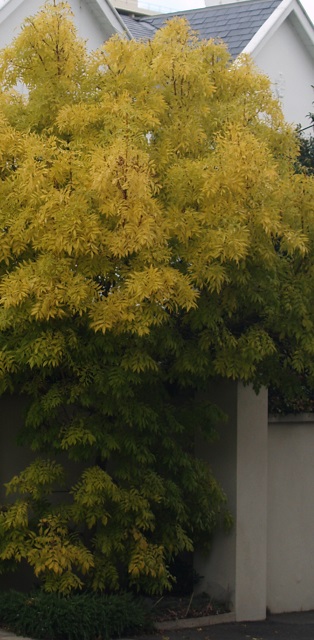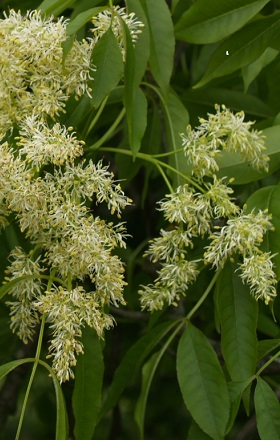Learn to identify, care for and use deciduous trees
Deciduous trees are a particularly important source of hardwood timber in many parts of the world; as well as being used for windbreaks on farms, as shade trees in parks, as street trees and major landscape specimens in gardens.
If you work in horticulture, particularly in a temperate or cold climate; a good knowledge of deciduous trees becomes a very important thing for competent performance of your work on a day to day basis. Without knowing and understanding deciduous trees you cannot select the appropriate variety for a particular location or know how safe a tree is (eg. whether it is susceptible to wood rot, if it is safe to climb, whether branches are likely to fall in a storm, etc). Foresters need to know how useful the timber is for construction, and even whether it burns easily or not (ie. whether it is good firewood).
- There is a great deal; that one can learn about deciduous trees.
- This course is a strong starting point; perhaps more so than any other such course on offer currently.
- If deciduous trees are your future; you can't go far past this course.
Lesson Structure
There are 8 lessons in this course:
-
Introduction
-
Taxonomy
-
Planting
-
Plant Selection
-
Soils
-
Nutrition and Fertilisers
-
Pruning
-
Propagation
-
Maple (Acer)
-
Introduction
-
Propagation
-
Culture
-
Pest and Disease
-
Species and Cultivars
-
Growing Acers in Pots
-
What affects foliage Colour Changes
-
Birch (Betula)
-
Characteristics of the Betulaceae Family
-
Betula genus overview
-
Commonly Cultivated Betula species and cultivars
-
Betula species not commonly grown
-
Birch Propagation; cuttings, layering, seed, grafting
-
Ash (Fraxinus)
-
Introduction
-
Fraxinus sub groups; sub genus Ornus, sub genus Fraxinaster
-
Variations in leaf colour
-
Selected cultivars
-
Less commonly cultivated species
-
Culture; pests, disease, propagation, etc
-
Oak (Quercus)
-
Overview of genus Quercus
-
Species and Cultivars
-
Culture
-
Prunus
-
Overview of the genus Prunus
-
Culture
-
Cultivars and Species
-
Plums
-
Apricot
-
Prunus persicae (Peach and Nectarine)
-
Cherry
-
Prunus Propagation
-
Other Deciduous Trees
-
Alnus
-
Cedrella
-
Lagerstroemia
-
Liriodendron
-
Liquidambar
-
Magnolia
-
Malus
-
Platanus
-
Populus
-
Pyrus (Pear)
-
Salix
-
Sambacus
-
Syringia
-
Ulmus (Elm)
-
Special Project - Plan the establishment of a collection of different cultivars of deciduous trees suited to growing in a specified locality.
Aims
-
Review foundation knowledge in plant identification and culture as needed to properly build expertise specific to deciduous trees.
-
Classify, identify and grow trees from a variety of genera including Acer, Betula, Fraxinus, Prunus and others.
-
Review a range of other significant deciduous tree genera not covered previously in this course.
-
Plan the selection and establishment of a collection of different cultivars of deciduous trees suited to growing in a specified locality.
A huge and very important topic
There are thousands of different types of deciduous trees in the world, and one could easily spend a lifetime studying them.
They are not only diverse though; but also very important. Deciduous trees sustain our environment, controlling temperature fluctuations, affecting rainfall patterns, ensuring soil stability and maintaining air quality. They provide us with building materials, and many of our fruit and nut crops; and much, much more.
Consider just one type of deciduous tree: the ash (Fraxinus). There are over 65 species of ash and here are some details (and by no means comprehensive details) covering just some of them:
How Well Do You Know Fraxinus -The Ash Tree?
Ash are mostly large trees belonging to the Oleaceae or olive family. They are indigenous to Europe, Asia and North America; and there are around 65 species.
They are mostly deciduous trees (occasionally evergreen); pinnate leaves; flowers are white green or yellow; winged seeds.
Culture
Grow in an open position, prefers freely draining moist soil, most soils types; responds to feeding, mulching and during hot periods, watering moderately. They will survive in air pollution, windy locations, and coastal areas.
Named cultivars are propagated commonly by grafting onto seedlings. Seed needs stratification (period of cold) to induce germination.
Health
Ash are hardy; can live over 300 years. Diseases include collar rot, stem rot, wood rot, mistletoe, canker, mildew, bracket fungi, and rust. Honey fungus may kill trees. Whilst generally pest-free they may occasionally be susceptible to leaf miners, whitefly, and scale insects. Shoot and crown die back may be a result of lack of moisture in the root zone.
Uses
Shade tree, feature tree, autumn foliage, windbreak; timber for cabinet making and tools, but it takes 60 years or more to mature.
Commonly Grown Cultivars/Species
F. americana (White Ash): 30 to 40m tall, occurs from Canada to the Gulf of Mexico (usually on good alluvial soils), very large trunk, rounded canopy; a particularly valuable timber tree in North America; young stems are shiny greyish green, bark on the trunk is a paler colour with a chequered pattern, generally good in mountains with a constantly moist soil.
F. angustifolia (Narrow-leaved Ash): 15 to 20m tall in the wild (from Southern Europe and north Africa), but sometimes smaller in cultivation; wide conical canopy (upright habit), low branches tend towards horizontal, while higher branches are more upright; young stems are smooth (glabrous) and olive green, while older twigs are grey-green with obvious semicircular leaf scars; leaflets are pale greenish white, and smooth.
F. chinensis (Chinese Ash): In China (in the wild) it grows normally alongside streams, to 15m tall in the wild but rarely over 8m in gardens, spreading branches form a wide conical crown, slightly drooped at the growth tips, leaves are green with a yellowish green under surface; autumn foliage is purple to reddish. Young stems are a shiny greenish brown, but older stems become grey with occasional brown markings. Winter buds are a very dark brown to black.
F. excelsior (English Ash, Common Ash): Fast and strong-growing (however, not as fast as F. Raywoodii or F. oxycarpa), 12 20m (occasionally but rarely to 40m tall). From Europe and Britain, foliage and branches tend to be open - particularly on older plants; foliage can develop yellowish autumn tones on some cultivars. Timber is very strong, and has a decorative grain making it valuable (it is often used for furniture, tool handles and sports equipment). Performs better on heavier soils than many other ash species however it prefers deep, cool, moist and well-drained soils. Frost hardy, partially tolerates air pollution.
F. excelsior ‘Aurea’ (Golden Ash): Moderately fast growing 6 to 10m, less hardy, spreading. (Some experts think this Australian cultivar may actually be the same as F. excelsior ‘Jaspidea’). Usually it is grafted onto F. oxycarpa rootstock.
F. excelsior ‘Crispa’ (Curl-leaved Ash): Slow-growing tall tree with black-green leaf stalk.
F. excelsior ‘Pendula’: A large tree, to around 8m tall with weeping branches.
F. floribunda: To 40m tall, slightly tender, from the Himalayas.
F. ornus (Flowering Ash, Manna Ash): A less vigorous root system than others yet can still be fast growing, to 13 m tall, clusters of scented white flowers, larger leaflets than other ashes. Autumn foliage can be brownish purple to coppery yellow. Winter buds are grey to brownish grey. Young stems are coppery-green; older twigs are greyish.

F. oxycarpa (Desert Ash): Fast-growing to 15m tall, very hardy tolerating hotter and drier conditions than most ash species; comes from southern Europe through Turkey and into Iran. Will grow on shallow and dry soils; foliage turns a butter yellow colour in autumn. Normally propagate by seed.
F. x raywoodii (Claret Ash): A South Australian seedling (possibly a hybrid) from F. oxycarpa, can be very fast growing, to 12m tall, forms a pyramidal shape, vivid glossy dark green leaves with a dull paler green underside, foliage turns a spectacular burgundy colour in autumn, tolerates dry conditions. New stems are bright green and smooth, older stems are grey-green. Usually it is grafted onto F. excelsior rootstock. Frost-hardy; does best in cool temperate areas (it produces better autumn foliage in areas which have snow over winter).
BENEFITS OF THIS COURSE
This course will build your plant knowledge.
If you struggle to name and describe many different deciduous trees, that will change dramatically. Even if your knowledge of deciduous trees is already good; it will expand well beyond what you already know.
You will become much better at choosing what tree to grow where; and knowing how to properly care for that tree from a small specimen right through to maturity.
This course will also enhance your business or career opportunities, across a wide range of industry situations, including:
- Tree Nursery Production
- Garden Centre Management
- Residential Gardening
- Commercial Garden Management
- Parks Management
- Landscape Design
- Urban Horticulture
- Street Tree Management
- Land Rehabilitation
- Tree removal, tree planting, tree surgery
- Forestry
- Landscape Construction
- Plant Breeding
ENROL or Use our FREE Course Advice Service to Connect with a Tutor